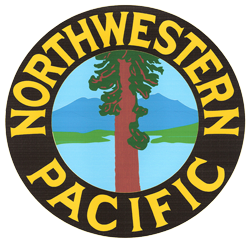From the November – December 2007 Headlight
From the Sawhorse of the Restoration Crew
P&SR Caboose #1 is a Diamond in the Rough
By Jeff Millerick
Get a load of this! Another complete set of trucks has arrived. The caboose’s siding is primed and coated with a base coat of caboose red. Installation will soon be completed.
There has been a flurry of activity around #1 – for only two work days a month, a lot gets done. John Schwirtz, Don Brewer and Mike Manson have gotten the end walls to the fresh primer stage – clean and smooth from all the layers of paint. The first coat of caboose red painted on our October 27 work day was a milestone.
Believe me, painting the color on is their privilege alone.
Meanwhile, Gus Campagna, Charlie Siebenthal and Skip Ruckert filled the remaining open areas in the roofing tongue and grove. Loren Williams was busy replacing the end corner T&G below the marker lamp brackets. When this job was completed, the north end was ready for primer, which John brushed on, giving the wall a fresh look. The primer was soon sanded and scraped, nail holes filled and another coat of prier applied. The wall looks close to new, yet retains its 100-year-old character.
Gus, Charlie and Skip moved their operation from the roof to the east wall saying, “Hey, let’s get some siding on this thing. She’s ready. We just might beat the Christmas Tree man before he shuts us down for the holidays. Let’s do it!” The bundle of new siding is broken open; the cut-off saw set up and the new siding is cut to length, 220-plus boards one inch longer than necessary. The quality of the wood is so good all the waste didn’t fill a plastic milk crate. Only a few knots and chips had to be cut out, leaving usable lengths. The boards were neatly stacked and ready for the next work day.
The crew brought their personal saw horses, then strung leftover 2 x 4s from #1’s framing between them. And the painting begins. Using Kelly Moore’s best oil-base wood primer the boards are painted five at a time – just enough to hold onto. First the tongue edges are painted generously (brushed on). The five boards are then rotated 180 degrees groove up, painted, then boards turned 90 degrees, runs on face brushed out, 180 degrees rotation again to backs, rolled and brushed. Then they’re rotated back to face-up for final roll and brush job, giving the faces a smooth surface with no runs showing. They are set aside face-up to dry. It’s a full day’s work for 100-plus boards. Next work day the process is repeated with water-base custom mix to match the original red. They dried quickly.
Gus, Skip, Charlie and Loren took them as soon as they were dry to touch and started the installation process, utilizing Gus’s nail gun shooting galvanized nails. No hammer marks and each nail is set perfectly. They put the boards up as fast as we could put the color on. By the next newsletter issue, this process will have been repeated and the other side will be on.
Meanwhile, Dave Turner has been rattle gunning and chipping the steel end platforem and oupler support beams. The cutting torch is also carefully fired up to cut large rusted bolts and straighten the steel to receive the new oak end timbers above the couplers. The steel is now straight and clean, ready for paint. The 250-300 pound roughed-out oak end timber is now wrestled into place for a trial fit, then removed to have a steel face fitted and the hand rail and ladder holed drilled later, to be installed next work season.
On top of all this, a full and complete set of trucks have been delivered. Dave Turner, while on a trip to the Mount Rainier Railway, noticed a pair of the exact trucks that #1 once had, sitting in the weeds. During a work day lunch, he says, “Get a load of this” and shows us photos. With a set this nice we won’t need to search further for wheels, bearings and who knows what else. The question is asked: “If you don’t mind, Dave, I will call them and ask. Surly they aren’t for sale, but it never hurts to ask.” The call was made and pleasantly answered. “Please give us a couple of weeks. We are extremely busy right now.” Sure. A couple of weeks later, I called again. “Yes, we will sell them to you for your restoration project. We have no use for them.” With a lump in my throat, the Big Question was asked: “How much?” Answer without hesitation: “Scrap value.” Answer: “We will take them.”
Harold and Jo Ann cut the check. Charlie Lix with his big rig was contacted to transport them and we used a large fork lift on this end to unload them. The folk lift rental was more than the cost of the trucks. Upon arrival and inspection all looks good – bearings, wheels, parts, pedestals which we have on our extra parts trucks are exactly the same manufacturer. All parts identical and interchangeable. How lucky can you get! Janney couplers, where are you?
PS: Thank you, Frank Morales, for sawing out the oak end timbers (a day’s work), and Lauren Williams for taking extra time to shape the ends.
Work on the caboose will pause soon as the restoration area will be used as a Christmas tree lot during the holiday season.return to top
